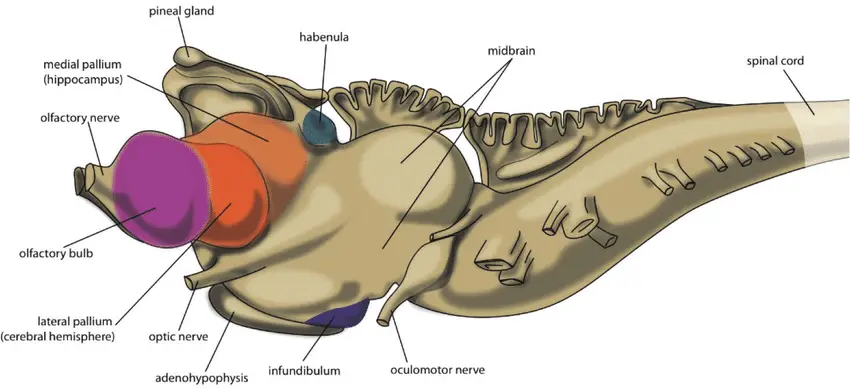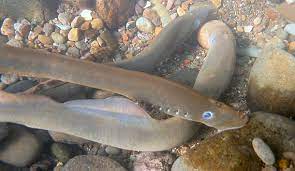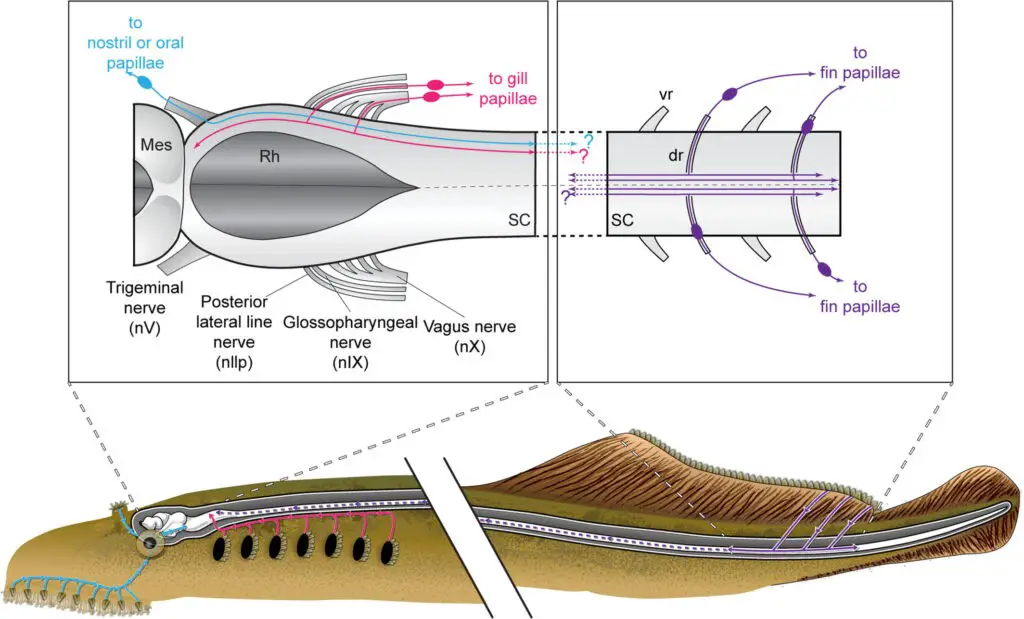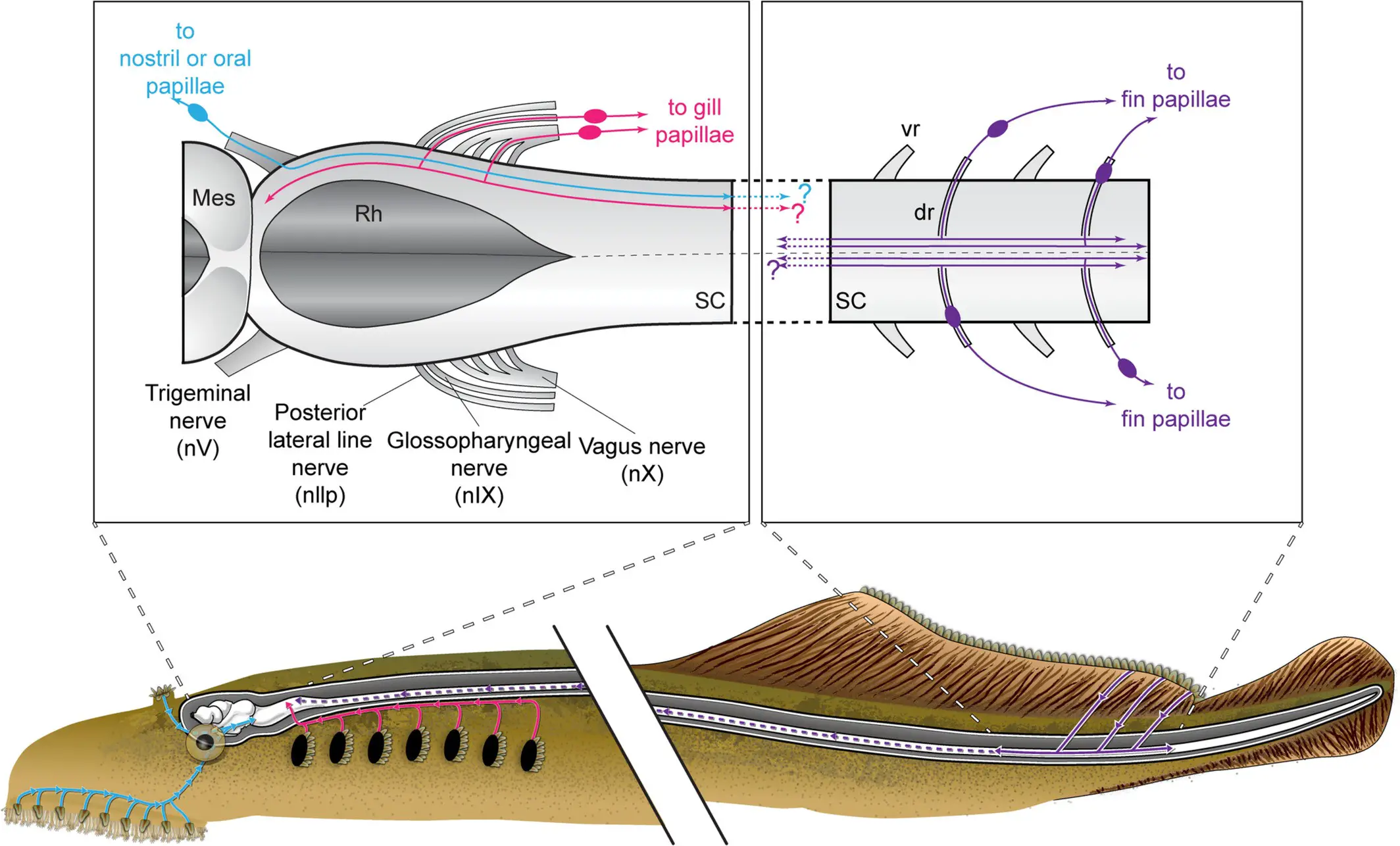Table of Contents
Nervous System of Petromyzon:
In Petromyzon, the nervous system has a very primitive brain, the main region of the brain, cerebral hemispheres are two in number and they are much separated from each other. The forebrain has two large olfactory lobes, on the posterior region, the cerebral hemispheres are connected to the diencephalon, on the dorsal side the diencephalon has a pineal gland, and the ventral side it has an infundibular organ.
Two large-sized optic lobes are present on the midbrain, in hindbrain have a medulla oblongata and cerebellum, the cerebellum is transverse and rudimentary in Petromyzon. The brain has ten pairs of cranial nerves, brain ventricles are four in number as seen in most of the higher Vertebrates.

The spinal cord is a flat ribbon-like shape, the spinal nerves have separate dorsal and ventral roots, in Petromyzon, the spinal cord has no blood supply which is not common in Vertebrate. In higher Vertebrate, the nerve fibers are insulated by myelin sheath but in Petromyzon, all the nerves are non-myelinated so the nerve impulses do not transmit at a faster rate as compared to myelinated nerve fibers.
The sympathetic nervous system is an extra feature in Vertebrate, in Petromyzon, the sympathetic nervous system is not well developed.
Sense Organs:
In Petromyzon, the important sense organs are – the olfactory organ, lateral eyes, median eyes, taste buds, lateral line, photoreceptor, and auditory organ. In the head the single nostril is responsible for the smell, the olfactory lobe is single but two the olfactory nerve are two in number, on the ventral side the olfactory lobe have a tube-like structure known as the pituitary pouch but its function is unknown.
The head has two lateral eyes and one median eye, they have a well-developed lens and the retina is pigmented which able them to see in the dark. The auditory organ has two vertical semicircular canals and an ampulla for the perception of sound waves in water. The pharynx region of Petromyzon has some buds-like structure for the perception of taste.
Petromyzon can produce electric fields in marine water which helps them to find their prey fish easily. On the lateral side and ventral side, the head has a lateral line sense organ which helps Petromyzon to understand different types of change in water.
On the skin of Petromyzon, especially on the tail region, Petromyzon has photosensitive cells which makes them aware of the intensity of light energy in water. Those sense organs help Petromyzon to understand different types of situations in the water, for example, to understand the movement in the water.
Excretory System in Petromyzon:
Mid dorsally a pair of mesonephric kidneys are the primary excretory organ in Petromyzon, the kidneys have straps like shape. The mesonephric kidneys have glomerulus which is highly vascularized, which blood flow through the blood vessels associated with the glomerular blood capillaries the nitrogenous waste materials go outside of blood into the mesonephric duct or ureter.

The extracted urine from each kidney flows through the ureter and reaches the urinogenital sinus. The urine then goes outside through the urinogenital papilla from the urinogenital sinus, the urinogenital papilla opens outside through the cloaca.
Reproduction in Petromyzon:
Petromyzon is dioecious, male and female are separate but in Ammocoet larval stage they are hermaphrodites, both male and female sex organs present together. But when they reach sexual maturity one of the sex organs becomes nature and produces gametes, around springtime they attain sexual maturity.
When they become sexually mature they migrate to the freshwater river for breeding purposes, the male Petromyzon looks for the female Petromyzon. The male Petromyzon goes to the bottom area of water where a large number of pebble is present, the male Petromyzon form nest using the pebble. When female Petromyzon reach the nest area, male Petromyzon wind his tail around female Petromyzon, then male Petromyzon release sperm cells, and female Petromyzon release eggs.

Adult female Petromyzon can a large number of eggs, fertilization occur in water externally, after fertilization the adult Petromyzon die.
Detailed Study On
Respiratory System and Circulatory System of Petromyzon
Digestive System and Feeding Mechanism of Petromyzon
Anatomy of Petromyzon (Lamprey)
External Morphology of Petromyzon
Habit and Habitat of Petromyzon(Lamprey)
Classification of Class Ostracodermi
Phylogeny of Subphylum Vertebrata
An Overview of Classification in Subphylum Vertebrata
Subphylum Vertebrata and its Diversity
Cephalochordata Characteristics Features Classification Examples and Diagram
Urochordata Classification Morphology Characteristic Features
Characteristics Features of Hemichordata
General Comparison of Hemichordata Urochordata and Cephalochordata
Comparative Study of Digestive System in Hemichordata Cephaochordata and Urochordata
Hi Everyone!!! Welcome to Imaluop. Imaluop always try to learn some new and he want to share to other people. Here we will try to learn various topics on Science, specially on Biological Sciences.
